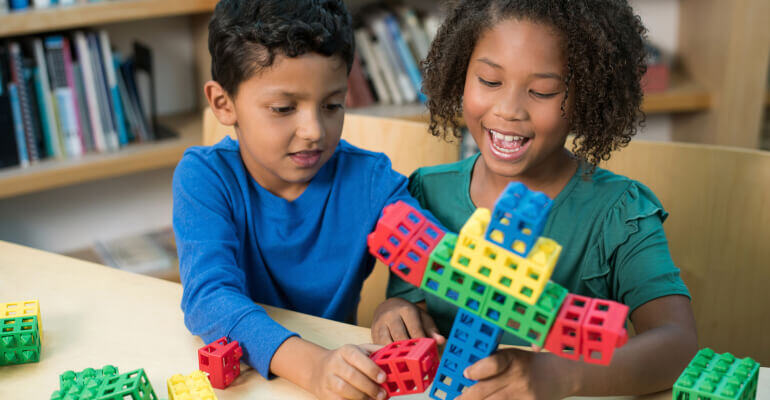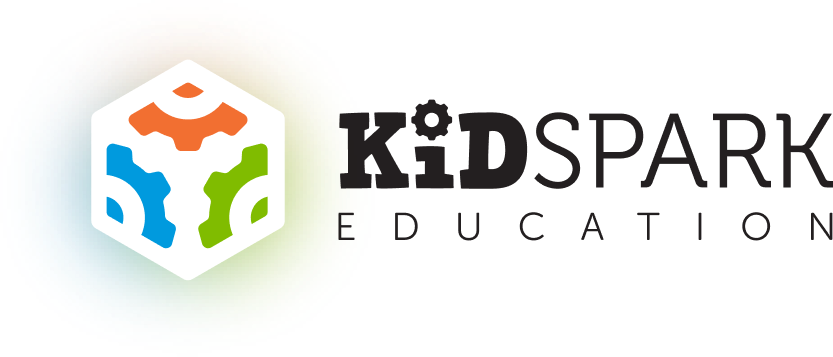
Too often, young students are taught that the scientific and the creative live in opposing worlds… that to be interested in the mathematical, one must forego a desire to explore the artistic. Educators, parents, and students are operating in a whole new world now. Not only can the left and right brain co-exist and work harmoniously as students learn, they should.
At Kid Spark Education, we believe that science, technology, engineering, and math (STEM) are not separate subjects — they’re deeply connected and depend on each other. We believe this approach is even stronger when art is added to STEM. By adding the arts to STEM, and creating STEAM (Science, Technology, Engineering, Arts, and Math), we empower students to explore these relationships through creativity. STEAM doesn’t treat art as an extra step; it utilizes art as an equally important pillar to strengthen how STEM disciplines work together, making learning more engaging and meaningful.

What Makes STEAM Special?
STEAM education goes beyond teaching individual subjects. It brings science, technology, engineering, and math together and uses art to tie them into a single, integrated experience. This approach helps students:
- See Connections in STEM: Art helps students understand how technology builds on science, how engineering relies on math, and how these seemingly unrelated disciplines are crucial to one another, not only in understanding but in application. By designing models that can be tested and improved, Kid Spark integrates art into the curriculum to show students that elegance and practicality don’t have to be mutually exclusive; they can work to enhance each other. Focusing on designs that are visually appealing and can optically communicate purpose and function, artful design invites deeper understanding for the engineer and robotics enthusiast alike.
- Think Critically and Creatively: Combining STEM with the arts leads to innovative problem-solving and fresh perspectives. For example, Kid Spark’s divergent design challenges give students open-ended problems to solve, encouraging them to brainstorm ideas and develop designs that utilize STEM creatively to find solutions.
- Stay Engaged: Creative projects make STEM topics more exciting, helping students develop a deeper interest in these fields. When ideas and theories are studied in isolation, students are too often incentivized to memorize facts, get tested on what they know, and then move on with minimal retained knowledge or expertise. Kid Spark’s integrated curriculum encourages students to go deeper than memorization and a surface-level understanding by completing STEM projects that require subject-matter expertise, critical-thinking skills, and creativity. This prompts an appetite and curiosity for learning beyond test-taking, equipping students with the inquisitive tools to keep asking questions and seeking connections outside of the classroom.
At Kid Spark Education, we design programs that highlight these connections, giving students hands-on opportunities to explore the integrated world of STEAM. We do this by exposing children to STEM subjects at the onset of their education, creating well-rounded learning environments, and then continuing with progressive STEM learning all the way through 8th grade. This foundation and consistency are key in helping close the STEM education achievement gap.

Benefits of STEAM Education
In addition to the benefits we’ve outlined above, there are many upsides to STEAM education for students with a deep interest in engineering — and openness to art integration.
1. Enhances Creativity in STEM
By combining art with STEM, students learn to think creatively about complex challenges. For example, when designing and building a structure, they apply math and engineering skills while using artistic principles to make it functional and visually appealing. Bringing creativity into traditionally practical fields boosts the vitality of each discipline both individually and together.
2. Encourages Deeper Understanding
STEAM projects allow students to see STEM concepts in action. For example, building a wind-powered device involves science (wind energy), technology (design tools), engineering (construction), and math (calculations)—with art making the design innovative and aesthetically pleasing.
3. Supports Collaboration
Art promotes teamwork by encouraging students to brainstorm ideas and work together to create solutions. This mirrors the way professionals collaborate in STEM fields. Traditional test-taking in silos has failed students in this regard. Allowing students to experiment collaboratively and with multiple disciplines simultaneously not only leads to a more complete understanding, it also starts building the tools they will need to work collectively in their future careers.
4. Makes STEM More Inclusive
The addition of art helps students who might not connect with traditional STEM lessons, creating an entry point for diverse learners with different interests and strengths. In the traditional classroom, where courses are segmented by various disciplines, students often gravitate towards subjects that interest them and away from subjects that don’t. By creating a more integrated and inclusive curriculum, students who are more captivated by artistic and creative pursuits than say math, for example, can see how their strengths and interests play an integral role in STEM education, too.

How to Bring STEAM to The Classroom
Bringing STEAM into the classroom can certainly can certainly make learning more exciting and dynamic! The methodology is limited only to the imagination of instructors and the resources they choose to use:
1. Focus on Hands-On Learning
Kid Spark Education’s programs for Pre-K–8th grade are built around hands-on STEM projects that integrate STEM and art. Students design, build, and refine their creations, learning how each discipline supports the others. Example: Students can create a robotic drawbridge that combines engineering principles, artistic design, and technology. This type of project shows how STEM and art work together to solve real-world challenges.
2. Use Technology Creatively
Incorporating tools like 3D printers or design software helps students develop both technical skills and creative thinking. By blending STEM with art, students gain hands-on experience with technology while learning to innovate and solve problems, preparing them for real-world challenges.Tools like the Kid Sparks open source 3D Virtual Parts Library further enhance this experience by allowing students to design and build their own parts, encouraging creativity and problem-solving in a practical, accessible way.
At Kid Spark Education, we are committed to helping students explore STEAM as an integrated system, not a collection of separate subjects. Adding art to STEM education strengthens these connections, helping students think critically, work collaboratively, and solve problems creatively. By embracing STEAM, educators can create richer, more engaging learning experiences that prepare students for a world where technical and creative skills go hand in hand. Let’s inspire the next generation to learn, love, and lead in STEM—powered by creativity!





